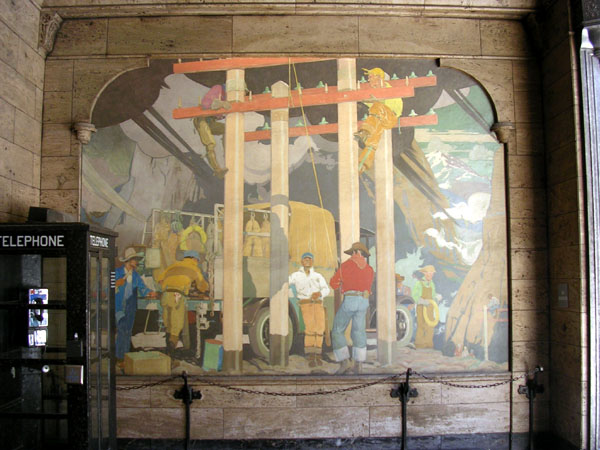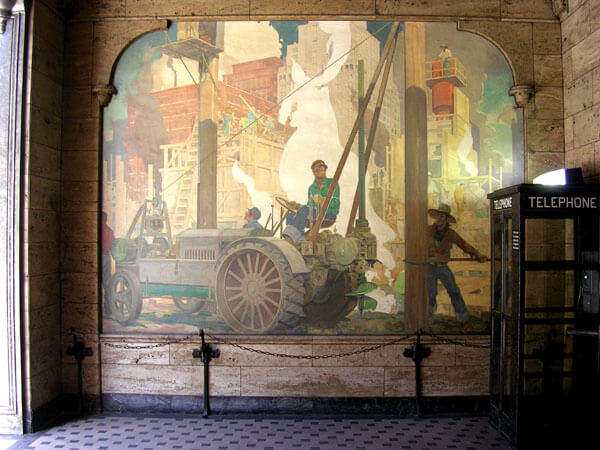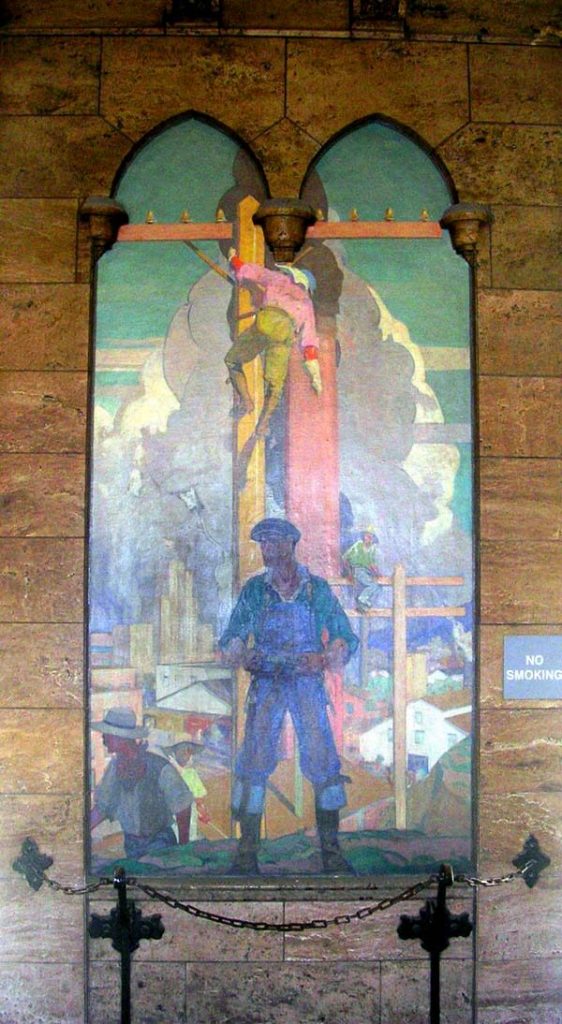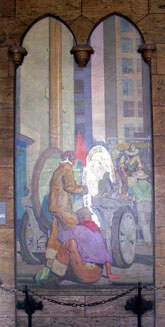Telecommunications History Group Resources
931 14th St. Historic Building
14th Street Outer Lobby - Allen Tupper True Murals
Mountain Telephone Construction
“Above timber line a construction crew is working on a sturdy H fixture at a point where the wires cross the Continental Divide, and where in its fury winter will wreak havoc.
“A rain cloud is passing; shadows drift over the peaks and the valley below is bathed in racing patches of sunlight. The scene is typical of telephone construction in parts of the Rocky Mountain Region.”
Notes: “H fixtures” were MST&T’s signature creation. These pole configurations were designed to stay up even in windy, icy conditions such as those found in the mountains, especially above timberline. (See a photo of the Loveland Pass H fixture, so large that it uses regular telephone poles as cross beams.)
The artist stretches the truth a bit in this mural. A truck as large as the one shown would not have made it to a rugged, roadless location. The phone company did, however, have other ways of getting heavy equipment to rugged areas.
City Telephone Construction
“In the roar of modern city building, the earth-boring machine is setting a pole with an efficiency that is almost human.
“In the background are modern building operations–the sinking of caissons, the laying of cribbing for deep foundations, and a steel skeleton starting skyward.
“A steam shovel adds to the turmoil of creative energy with which the city telephone crew carries on its construction to keep pace with the progress of the city.”
Notes: This modern machine both dug holes for and planted the giant telephone poles. Up until this, this work was all performed manually, using long-handled spades and “spoons,” and levers to raise the poles.
The Lineman – A Character Study
“The Lineman – one of the telephone men who string thousands of miles of wire over rivers, mountains, plains and deserts to make a neighborhood of the nation.”
Notes: Pole climbing is becoming a lost art today, as fewer and fewer poles are being used; instead, companies now prefer to lay lines underground.
“tipi-ing the pole”: The poles were sharpened to a point on top (like a giant pencil) in order to let the rain run off. Why was this important? Because any water accumulating on the top of an untreated pole would hasten rot.
You can tell when an artist has a true representation of a lineman when the lineman’s knees are bent. No one who knew what they were doing would go up a pole and stand with their knees straightened, as this would lead to “burning the pole”–sliding down the pole feet-first while being held very, very close to it by your lineman’s belt.
The insulators (the coverings poking up from the crossbeam at the top of the pole) are actually the wrong color–the phone company didn’t use any tan or brown insulators. The artist claimed that he “liked it that way,” and he may have, but the real reason for the coloring is that the usual insulator colors (green or blue) wouldn’t have shown up very well against the blue-sky background.
The Underground Cable Crew
“The Cable Reel Crew–Men are preparing to run thousands of lines of communication through conduits under the city streets.
“One of the results of the work of the cable crew is the beautification of the street itself.”
Notes: The cable wheel wagon could probably be used today, as the cable wheel could hold fiber optic cable as easily as it once held lead-sheathed copper cable.
The difference would be that, while it could hold 200 feet of old, 600 pair cable (a type of cable that could serve 1,200 customers), it could hold two or three miles of fiber optic cable (able to serve 50-60,000 customers).
(Please note that the italicized text accompanying the murals is adapted from a 1929 pamphlet put out by the telephone company to promote the murals and the building.)




